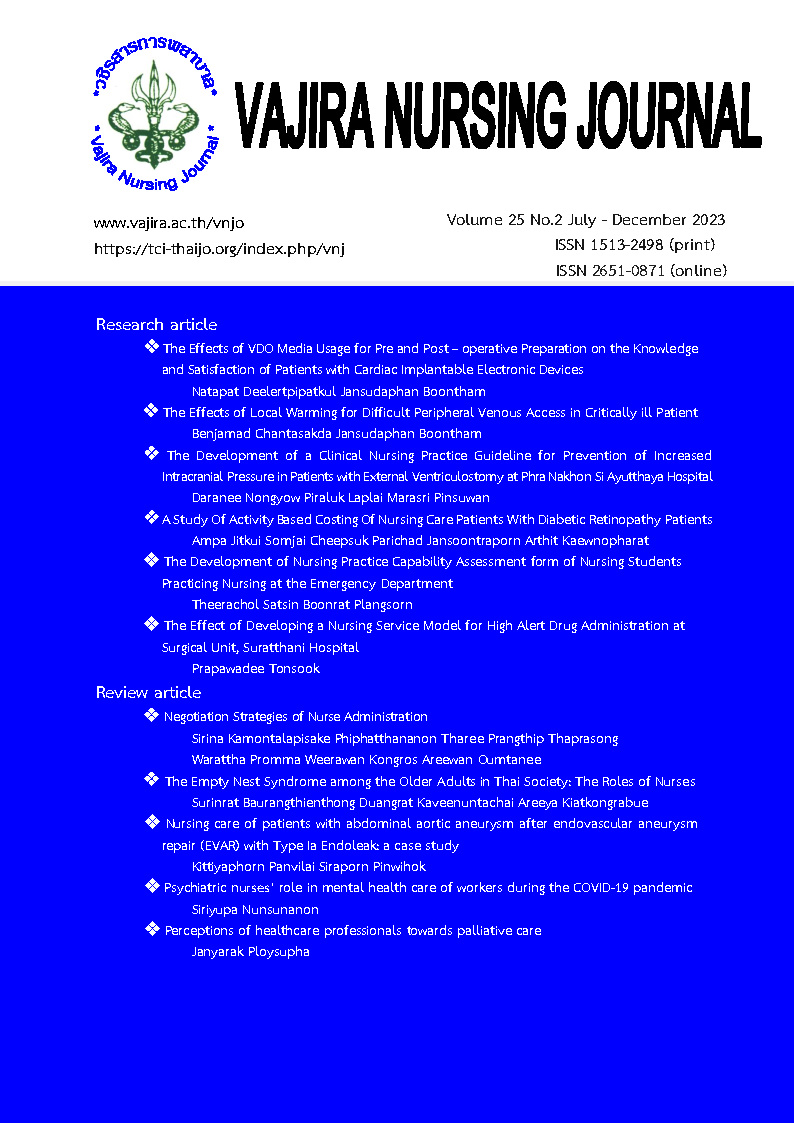ผลของการประคบอุ่นต่อการทำหัตถการเปิดหลอดเลือดดำ ในผู้ป่วยที่หาหลอดเลือดดำยากในหอผู้ป่วย เพชรรัตน์ 4C (หอผู้ป่วยวิกฤตโรคหัวใจ)
Main Article Content
บทคัดย่อ
การศึกษาครั้งนี้เป็นการวิจัยกึ่งทดลอง วัตถุประสงค์เพื่อศึกษาเปรียบเทียบการเปิดหลอดเลือดดำสำเร็จระหว่างการประคบอุ่นด้วยผ้าร้อนไฟฟ้าก่อนเปิดหลอดเลือดดำกับเทคนิคการเปิดหลอดเลือดดำแบบปกติ ในผู้ป่วยที่หาหลอดเลือดดำยากโดยมีสมมุติฐานคือการประคบอุ่นก่อนการเปิดหลอดเลือดดำในผู้ป่วยวิกฤตที่มีหลอดเลือดดำหายากมีความสำเร็จมากกว่าการเปิดหลอดเลือดดำตามรูปแบบปกติ
กลุ่มตัวอย่างคือ ผู้ป่วยที่เข้ารับการรักษาตัวในหอผู้ป่วยเพชรรัตน์ 4C คณะแพทยศาสตร์วชิรพยาบาล มหาวิทยาลัยนวมินทราธิราช จำนวน 160 คน แบ่งเป็นกลุ่มควบคุมคือ กลุ่มที่ได้รับการเปิดหลอดเลือดดำตามเทคนิคปกติ จำนวน 80 คน และกลุ่มที่ทดลองที่ได้รับการประคบอุ่นด้วยผ้าร้อนไฟฟ้าอุณหภูมิ40-45 องศาเชลเซียสเป็นเวลา 15 นาที ก่อนเปิดหลอดเลือดดำตามเทคนิคปกติ จำนวน 80 คน การคัดเลือกกลุ่มตัวอย่างแบบสุ่มเป็นบล็อกโดยใช้โปรแกรมคอมพิวเตอร์ตามเกณฑ์คัดเข้า ระหว่างวันที่ 15 มกราคม
2563 - 31 มีนาคม 2564
ผลการศึกษา พบว่า กลุ่มทดลองที่ใช้วิธีการประคบอุ่นสามารถเปิดหลอดดำสำเร็จร้อยละ 98.8 ส่วนใหญ่สำเร็จในครั้งแรกร้อยละ 70 กลุ่มควบคุมที่ใช้วิธีการเปิดหลอดเลือดดำตามรูปเทคนิคปกติสามารถเปิดหลอดเลือดดำสำเร็จร้อยละ 72.5 และสามารถเปิดสำเร็จในครั้งแรกร้อยละ 30 การเปิดหลอดเลือดดำสำเร็จระหว่างกลุ่มทดลอง และกลุ่มควบคุมแตกต่างกันอย่างมีนัยสำคัญทางสถิติ (p-value≤0.001) และจำนวนครั้งของการเปิดหลอดเลือดดำสำเร็จระหว่างกลุ่มทดลองและกลุ่มควบคุมแตกต่างกันอย่างมีนัยสำคัญทางสถิติ (p-value≤0.001)
Article Details

อนุญาตภายใต้เงื่อนไข Creative Commons Attribution-NonCommercial-NoDerivatives 4.0 International License.
เนื้อหาและข้อมูลในบทความที่ลงตีพิมพ์ในวชิรสารการพยาบาลถือเป็นข้อคิดเห็นและความรับผิดชอบของผู้เขียนบทความโดยตรง ซึ่งกองบรรณาธิการไม่จำเป็นต้องเห็นด้วย หรือร่วมรับผิดชอบใด ๆ ทั้งสิ้น
บทความ ข้อมูล เนื้อหา รูปภาพ ฯลฯ ที่ได้รับการตีพิมพ์ในวชิรสารการพยาบาล ถือเป็นลิขสิทธิ์ของวชิรสารการพยาบาล หากบุคคลใดหรือหน่วยงานใดต้องการนำทั้งหมดหรือส่วนหนึ่งส่วนใดไปเผยแพร่ต่อหรือเพื่อกระทำการใด ๆ จะต้องได้รับอนุญาตเป็นลายลักอักษรจากวชิรสารการพยาบาลก่อนเท่านั้น
เอกสารอ้างอิง
Helm RE, Klausner JD, Klemperer JD, Flint LM, Huang E. Accepted but unacceptable: peripheral IV catheter failure. J Infus Nurs. 2015; 38(3): 189-203.
Marsh N, Webster J, Mihala G, Rickard CM. Devices and dressings to secure peripheral venous catheters: A Cochrane systematic review and meta-analysis. International Journal of Nursing Studies. 2017; 67: 12-9.
Eren H. Difficult Intravenous Access and Its Management. 2021.Retrieved from https://www.intechopen.com/chapters /75477.
Alexandrou E, Ray-Barruel G, Carr PJ, Frost SA, Inwood S, Higgins N, et al. Use of short peripheral intravenous catheters: characteristics, management, and outcomes worldwide. Journal of hospital medicine. 2018; 13(5).
Hilton E, Haslett TM, Borenstein MT, Tucci V, Isenberg HD, Singer C. Central catheter infections: single- versus triple-lumen catheters. Influence of guide wires on infection rates when used for replacement of catheters. Am J Med. 1988; 84(4): 667-72.
Biyik Bayram S, Caliskan N. Effects of local heat application before intravenous catheter insertion in chemotherapy patients. J Clin Nurs. 2016; 25(11-12): 1740-7.
Robinson-Reilly M. Application of heat prior to intravenous catheter insertion to improve comfort and safety for patients requires further research. Evid Based Nurs. 2017; 20(1): 15.
Homayouni A, Tabari-Khomeiran R, Asadi-Louyeh A. Investigating the effect of local warming on vein diameter in the antecubital area in adults aged 20-40 years. Br J Nurs. 2019; 28(8): S20-s6.
Kozier B. Fundamentals of nursing: concepts, process and practice: pearson education; 2008.
Potter PA, Perry AG, Stockert PA, Hall A. Fundamentals of nursing-e-book: Elsevier health sciences; 2021.
Yamagami Y, Tomita K, Tsujimoto T, Inoue T. Tourniquet application after local forearm warming to improve venodilation for peripheral intravenous cannulation in young and middle-aged adults: A single-blind prospective randomized controlled trial. International Journal of Nursing Studies. 2017; 72: 1-7.
Sarsar A, Kumari V, Sharma T, Sarin J. An experimental study to assess the effect of moist heat therapy on ease of peripheral venous cannulation among patients admitted in selected hospital of Ambala, Haryana. Int J Health Sci Res. 2019; 9(1): 104-11.
Tokizawa Y, Tsujimoto T, Inoue T. Duration of venodilation for peripheral intravenous cannulation, as induced by a thermal stimulus on the forearm. Biological research for nursing. 2017; 19(2): 206-12.
Rose Mary G, Hemant T. Effectiveness of moist heat therapy on the visibility and palpability of peripheral veins before peripheral venous cannulation among patients undergoing intravenous cannulation. Journal of Pharmaceutical Negative Results. 2022: 1823-33.
Simarpreet K, Ruchika R, Prabhjot S, Jasbir K. Effect of moist heat therapy on the visibility and palpability of veins before peripheral intravenous cannulation of patients undergoing chemotherapy. Int J Adv Res. 2018; 6: 230-6.
สุดารัตน์ สุวรรณเทวะคุปต์,พวงยุพา ยิ้มเจริญขวัญชนก ดาวฮามแป. ผลของการประคบอุ่นต่อความ ปวดระหว่างการเจาะเลือดของเด็กวัยเรียน.Thai Journal of Nursing Council. 2018; 33: 59-69.
Lenhardt R, Seybold T, Kimberger O, Stoiser B, Sessler DI. Local warming and insertion of peripheral venous cannulas: single blinded prospective randomised controlled trial and single blinded randomised crossover trial. Bmj. 2002; 325(7361): 409.
Korkut S, Karadağ S, Doğan Z. The Effectiveness of Local Hot and Cold Applications on Peripheral Intravenous Catheterization: A Randomized Controlled Trial. Journal of PeriAnesthesia Nursing. 2020; 35(6): 597-602.


